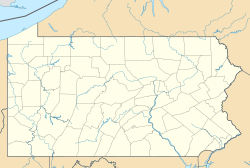Cambria City Historic District facts for kids
Quick facts for kids |
|
|
Cambria City Historic District
|
|

120 Chestnut St in the district
|
|
| Location | Roughly bounded by Broad St., Tenth Ave. and the Conemaugh River, Johnstown, Pennsylvania |
|---|---|
| Area | 39 acres (16 ha) |
| Built | 1889 |
| Architect | Multiple |
| Architectural style | Queen Anne, Second Empire |
| NRHP reference No. | 91001706 |
| Added to NRHP | November 14, 1991 |
The Cambria City Historic District is a special area in Johnstown, Pennsylvania. It's like a time capsule, showing what life was like for working-class families in the past. This district has many old buildings, including homes, shops, and churches, that tell stories about the city's history. It was officially recognized as a historic place in 1991.
Contents
Discovering Cambria City
The Cambria City Historic District is a unique neighborhood in Johnstown. It's known for its many old buildings that have been preserved. This area helps us understand how people lived and worked a long time ago. It's a great example of a historic district, which is a group of buildings, structures, or sites that are important because of their history or architecture.
A Glimpse into the Past
This historic district covers about 39 acres. It includes 198 buildings and one special structure that are considered important to its history. Most of these buildings were homes for people who worked in Johnstown's industries. You can also find a small area with businesses and some old industrial buildings. These include a former brewery, a bottling plant, and even a slaughterhouse. The district also has many beautiful churches and schools.
After the Flood
Some buildings in Cambria City were built before the famous Johnstown Flood. This terrible flood happened in 1889. However, most of the buildings you see today were built between 1890 and 1920. This means they were constructed after the flood, as the city rebuilt itself.
Buildings You Can See
Cambria City is home to many interesting buildings. They show different styles of architecture from the past.
Homes and Businesses
Many of the homes are two-story houses. They were built using a method called "balloon frame" construction. These homes are either detached (standing alone) or semi-detached (sharing a wall with another house).
Some notable buildings include:
- The Fifth Avenue Hotel (built in 1889)
- The Pollack Building (built in 1905)
- The old Cambria Fire Hose and Ladder Company building (built in 1890)
- The former Germana Brewery (built in 1907)
- The August and Louisa Mayer Building (built in 1907)
- The Tulip Bottling Company (used from 1913 to 1949)
Churches and Community Spots
The district is also famous for its collection of churches. These churches represent the many different groups of people who settled in Johnstown. They include:
- St. Casimer's Polish Church (built in 1907)
- Immaculate Conception Church (built in 1908)
- St. Stephen's Slovak Church (built in 1914)
- St. Columba Church (built in 1914)
- St. Mary's Greek Catholic Church (built in 1922)
- The Venue Of Merging Arts (which used to be St. George's Orthodox Church, built in 1911)
- The Hungarian Reformed Church (built in 1902)
- The First Catholic Slovak Band Hall (used from 1913 to 1949)
The Minersville Bridge
Besides the buildings, there is one important structure in the district: the Minersville Bridge. This bridge was built in 1914. It is an important part of the district's history and transportation.
Why is it Historic?
The Cambria City Historic District was added to the National Register of Historic Places in 1991. This means it's recognized by the United States government as a place worth preserving. It helps us remember and learn about the history of Johnstown and the lives of the people who lived there.



